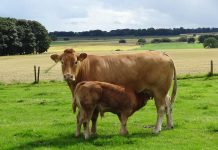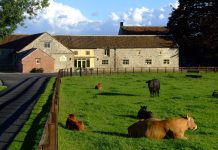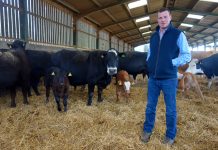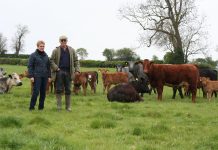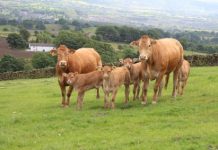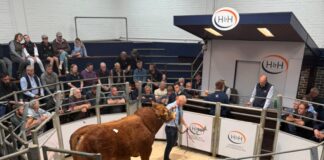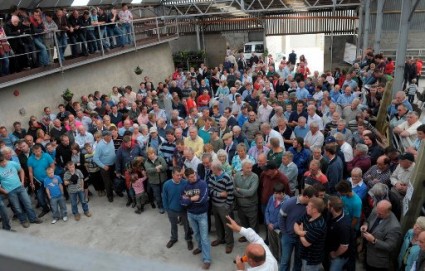 A huge estimated crowd of around 3,500 people attended what was a spectacular Northern Ireland Limousin Club Open Day held in August 2009 at the Corrie Family Farms situated on the Ards Peninsula, County Down. The large crowd came from all corners of the UK and Southern Ireland and gained not just a rich impression of the quality of the Limousin stock but the glorious Open Day sunshine helped create the festive air of a local show, with visiting families greeted by dozens of tradestands, machinery demonstrations, stockjudging competitions as well as hospitality and fun attractions such as a bouncy castle and rodeo bull! The farm shop, packed with quality beef products, was also packed with customers and was described by Will as being like ‘a Christmas trade’. Benefiting from the generosity of the Open Day hosts and attendees was the Motor Neurone Association and a cracking £20,000 was raised through donations and a charity auction for this very worthwhile cause.
A huge estimated crowd of around 3,500 people attended what was a spectacular Northern Ireland Limousin Club Open Day held in August 2009 at the Corrie Family Farms situated on the Ards Peninsula, County Down. The large crowd came from all corners of the UK and Southern Ireland and gained not just a rich impression of the quality of the Limousin stock but the glorious Open Day sunshine helped create the festive air of a local show, with visiting families greeted by dozens of tradestands, machinery demonstrations, stockjudging competitions as well as hospitality and fun attractions such as a bouncy castle and rodeo bull! The farm shop, packed with quality beef products, was also packed with customers and was described by Will as being like ‘a Christmas trade’. Benefiting from the generosity of the Open Day hosts and attendees was the Motor Neurone Association and a cracking £20,000 was raised through donations and a charity auction for this very worthwhile cause.
Commenting on the success of the Open Day, British Limousin Cattle Society Chairman, Jim Bloom said: “This was not only a real feel-good day but also a tremendous showcase for the commercial attributes of the Limousin breed. I congratulate the NI Limousin Club for their fantastic organisation and thank the Corrie Family for being such generous and willing hosts.” In this issue of Limousin, the herd and farm is profiled in depth in the excellent technical feature ‘Can the average suckler farmer meet the Corrie Challenge?
Unique Corrie enterprise built on professionalism an Limousins
The following technical feature was written by Irish Farmers Journal Livestock Editor Justin McCarthy and was printed in August 2009 following the Corries’ Open Day. It is reprinted here by the kind permission of Justin McCarthy and the Irish Farmers Journal and the BLCS’s thanks are extended to them. Pictures are supplied through the BLCS.
Can the average suckler farmer meet the Corrie Challenge?
Calving down 85% of the 270 cow herd in just 12 weeks, averaging over 400kg deadweight for 23 month steers, and producing a total farm gross margin of £683/ha – Irish Farmers Journal Livestock Editor Justin McCarthy asks if the average suckler farmer can meet the Corrie Challenge, or is it a step too far?
In August, I had the pleasure of travelling up to the Ards Peninsular to attend the Northern Ireland Limousin Cattle Club open day, hosted by Will Corrie and family.
The Corrie farm, located just 12 miles from Belfast, is no ordinary farm. It is not only unique in terms of scale – extending to over 400ha (1,000 acres) – but also for the fact that all progeny produced from the 270 cow suckler herd, along with 150 dairy bred calves transferred from the dairy herd, are sold through the family’s network of three butcher shops.
But let’s leave the sale and butchery business aside for now. Another factor that adds to the uniqueness of the Corrie’s beef unit is the level of professionalism to which it is operated.
Within five minutes of walking into the yard, you quickly get a sense of the level of pride and professionalism to which Will’s son, Gareth Corrie, and farm manager Phillip Savage operate. Despite the beef operation extending to 200ha (500 acres), there is still no room for passengers. Any of the 270 cows that are not doing the job in terms of fertility or weaning quality are immediately culled.
Over the past few years, the focus on the farm has been to cull hard in order to end up with a herd of highly productive cows that produce calves with excellent conformation and growth rates. As a result, the bulk of the herd now consist of three-quarter bred Limousin cows.
Despite the severe culling policy, they have also been building cow numbers. In 2008, 66 heifers calved down in the herd, while a further 70 calved down in 2009.
All of the heifers are sourced from within the herd. Heifers for breeding are selected at 10 to 12 months of age, when they are being turned out to grass after the first winter. The Ards Peninsula men certainly don’t buy into the problems associated with calving heifers down young. All of the heifers on the farm calve down at between 22 and 24 months of age.
Based on the fact that 85% of the main herd calves down within a period of 12 weeks, there certainly doesn’t appear to be a problem with subsequent fertility in these young heifers (see Table 1). Nor does calving heifers down at 22 to 24 months stunt their growth – the mature cows on the Corrie farm have excellent scope and frame.
Looking at this year’s crop of maiden heifers, it is obvious that the reason the pitfalls associated with calving down at 22 to 24 months are being avoided is because of how the heifers are managed and selected. As was shown, for heifers that are just 15 to 16 months of age, they have exceptional power and frame, and are on average 450kg to 500kg liveweight. Unlike some farms, where it is the lighter heifers, those unsuitable to take to the mart, that are kept for breeding, the policy on the Corrie farm is only to keep the very best heifers for breeding. The key selection criteria when identifying heifers for breeding are growth rate, conformation and the quality of the dam.
Length of the loin
The focus of the breeding policy on the farm is to produce lively calves with a fast growth rate, good killout and fine textured meat.
It is for this reason that although the bulk of the herd now consists of three-quarter bred Limousin cows, a Limousin bull is still used as a terminal sire.
When I asked Gareth why he did not bring a second breed into the mix, he simply replied: “Our plan is to drive up output by going up to 300 cows next year. To do this, we need to operate an easy calving system that produces a calf that has plenty of vigour and will get up and suckle quickly.”
Gareth believes that, provided you can get length into the loin, there is no truth to the theory that the Limousin will not weigh when slaughtered. The focus on the length of the loin in the breeding policy was clear when walking through both the cows and the stock bulls.
All of the young cows in the herd had exceptionally deep loins, with great length, as did the maiden heifers and this year’s beef bullocks.
The importance of the loin length in achieving weight in evident from the carcase weights achieved last spring. Steers averaged 405kg at 23 months, with the heifers averaging 326kg at 22 months. All animals, including those transferred from the dairy herd, are housed and fed an intensive diet before slaughter.
Pulling the calving date forward
As the sucker herd continues to expand, the plan is to pull the calving date forward by four weeks. Currently, the target calving date is from February to April. However, as the herd hits 300 cows, the plan will be to start calving in January.
The reason for pulling the calving date forward is to try and get calves going out to grass stronger, and push up weaning weights. The earlier the calving date, plus the increase in cow numbers, has been facilitated through the construction of two new sheds. The majority of the sheds on the farm are solid floor, with a slatted feeding area at the front, and a creep area for calves at the back. The sheds are either bedded down using woodchips or straw.
Achieving a tight calving interval
Last year, 85% of the 270 cows calved down within a 12-week period. When I enquired how Gareth managed to keep the calving interval so tight, his answer was embarrassingly simple – “I take out the bulls”.
Obviously achieving such a tight calving interval without having to cull excessive numbers of cows involves a bit more than just taking the bull out.
The selection of the replacement heifers has a major role to play. Selecting heifers from the most productive and functional cows in the herd means they are starting from a good base.
After that, it is down to management of both the cow and the bull.
The condition score of the cow is one area that receives close attention on the farm. When dried off, the cows are housed and fed a diet of silage and straw.
Having built up good covers over the summer, the aim is to feed a below maintenance diet at the start of the housing period.
The silage for the cows is selected from the top of the pit and mixed in, along with straw. Two to three months from calving, minerals are introduced, and cows or heifers that are poor in condition are fed concentrates.
Management of the stock bull
Correct management of the stock bulls is also critical for ensuring a tight calving pattern.
This year, a total of nine bulls were put out with 300 cows/heifers, giving an average of 34 cows per bull.
When young bulls come on to the farm, they are purchased at least seven months in advance of the breeding season. This ensures that they are well settled before being called into action.
At the end of the breeding season, the bulls are all grazed together in two groups of four or five.
During the winter, they are housed in the same groups, and fed a diet of silage and 2kg to 3kg of concentrate. They are examined regularly in advance of the breeding season to ensure they are in good health and fully functional.
Weaning and finishing
The Corrie system is a high input system operating at almost 3LU/ha. Concentrate input per cow unit is 1.1L/t. Concentrates are introduced to the calves from three months of age, and increased to 1.75kg per day before weaning at the age of seven months of age.
Weaning is a gradual process, with cows removed from the herd at various intervals. When housed, weanlings are carried over the first winter on a total mixed ration of silage, straw and 2kg of concentrates.
When they go back out to grass, they remain on 1kg of concentrate for the duration of the summer. When housed the following winter, they are fed a diet of 3kg concentrates, plus ad-lib silage.
Towards the end of the feeding period, the rate of concentrate will be increased to 5kg to 6kg to help get a cover on the more muscular cattle.
Minimal machinery and two labour units
Investment in machinery is minimal. Despite carrying over 850 head during the winter, the only items of machinery on the farm are a tractor, a diet feeder and a loading shovel. All other machinery work on the farm is carried out using a local contractor. The farm is also designed to ensure that labour input is kept to a minimum. On average, there are two labour units on the farm throughout the year.
The low labour demand, relative to the size of the operation, is achieved through a series of internal roadways throughout the grazing block, and an exceptionally well-designed cattle yard, which is equipped with excellent handling facilities.
The yard is designed so that one farmer can move any pen of animals from the shed to the crush.
Who said the Limousin was wild?
One thing that struck me as I walked down the farm roadway was how quiet the stock on the farm were.
Although this was a large scale operation, the stock out on the land were exceptionally quiet, and despite being fenced in along by the farm laneway, they lay contented as people walked by. It proves just how important management is with regards to docility. Despite some of the calves being almost 7/8th Limousin, they were exceptionally quiet. Even the maiden heifers and young cows were very settled, despite the crowds of people.
Table 1: Fertility report for Corrie Farm 2007 to 2009
| Year | Calving interval (cows) | Reappearance rate @ 365 days (%) | Calving index (heifers) | % of herd calving within 12 weeks |
| 2007 | 370 | 71% | 366 | 78 |
| 2008 | 358 | 62% | 343 | 90 |
| 2009 | 372 | 71% | 366 | 85 |
What does the future hold?
As a young farmer, Gareth Corrie is focused on driving the business forward. His motto is simple – “if you are not pushing forward, then you start to go backwards.”
It is therefore little surprise that the County Down man plans to push cow numbers to over 400 within the next five years.
When I asked him about the future of the business, he said: “I am confident that a well-run suckler to beef operation will deliver me a viable return.
“While we have three butcher shops, each business is assessed individually, with separate financial accounts. The same applies to both the dairy unit and the suckler herd.
“All the beef cattle sold off the farm are transferred at market values, so as I know exactly what return the farm is generating.
“In the long-term, I will focus on continuing to drive up output by growing the herd to 400 cows and further improving the cow quality,” he said.
Like many of the top performing suckler herds in the country, Gareth Corrie is doing nothing out of the ordinary. He is just doing the simple things well. For example:
- Keeping the calving pattern tight.
- Selecting the right type of cow to match the system.
- Using top genetics.
- Focusing on maximising output.
- Achieving high levels of gain from grass.
By doing these simple things well, he is managing to achieve an excellent level of fertility, carcase weight for age and overall, a good gross margin per ha.
However, like any good businessman, Gareth is not prepared to sit back on what he has achieved to date. He intends to continue to develop and improve the business in an attempt to further drive up returns.







